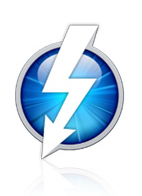 This morning’s upgrades to Apple’s iMac line of computers brought a range of nice features. But most were just spec bumps. The big new addition is Thunderbolt. Following the initial roll-out to the MacBook Pros, the new super high-speed ports are clearly destined to be a key component across Apple’s product lines. But what about Apple’s two key newer products: the iPhone and iPad? Apple hasn’t said a word yet about what Thunderbolt means for them.
This morning’s upgrades to Apple’s iMac line of computers brought a range of nice features. But most were just spec bumps. The big new addition is Thunderbolt. Following the initial roll-out to the MacBook Pros, the new super high-speed ports are clearly destined to be a key component across Apple’s product lines. But what about Apple’s two key newer products: the iPhone and iPad? Apple hasn’t said a word yet about what Thunderbolt means for them.
During a call with Apple this morning, I specifically asked about when we might see Thunderbolt-enabled adapters for iPhone/iPad. Apple would only say that they had nothing to share at this time. That’s usually code for “it’s coming, but just not yet.” And that makes sense. Why pour all this money into a new technology if you’re not going to use it in places where it makes the most sense? But it’s also not that simple.
When I asked what devices were coming that would take advantage of Thunderbolt, I was pointed to this site which features some pre-announced third-party devices at the bottom of the page. These include external hard drives, video capture devices, and adapters (to convert Thunderbolt pipes to carry FireWire data, etc). Apple said they expect to see the first such devices at some point this spring. In other words, soon.
But again, none of those listed are Apple devices. Why haven’t we heard anything about those yet? Could it be because Apple is planning to replace all computer-based syncing with syncing in the cloud when Castle/iCloud is unveiled later this year?
I wouldn’t hold my breath.
My hunch is that we will hear something from Apple later this year about Thunderbolt use with iPads/iPhones. Perhaps during the iPhone 5 unveiling in the fall. Now that the technology is out there on two of their most popular devices (MacBook Pros and iMacs) and probably pretty soon on another one (MacBook Airs), Apple will have to address this. And the reality is that Thunderbolt (and even still USB) seems to be a more viable and smart near-term solution for device sync rather than a full-on cloud sync.
A few weeks ago, Daring Fireball’s John Gruber made the case for why Apple is taking their time with regard to cloud-based syncing in the “post-PC” world. While Apple does already sync small amounts of data like calendars and email (via MobileMe) and e-books (via iBooks) in the cloud, the big chunks of data (music, movies, etc) still require a computer for syncing. The main issue is simply speed. Wireless networks are not nearly fast enough to transfer gigabytes of data up and downstream in a reasonable amount of time. And this will not change anytime soon. Not even with 4G/LTE network speeds.
Media streaming (either over the cloud or via WiFi) is one potential solution. But it’s not a full solution. Apple is also going to want to have a solution for people who want to have this media actually present on their devices (for trips and such). That means sync. And the cloud is just not ready for that yet.
 Enter Thunderbolt.
Enter Thunderbolt.
One big problem that users have with the iTunes-based syncing mechanism for iPhones/iPads today is that it’s slow. Apple has done a lot of work to speed this up over the years (remember when backups would take something like 30 minutes to an hour!?), but it’s still not ideal. Thunderbolt could help alleviate this pain point.
Right now, iPhone/iPad syncing is done via USB 2.0. These ports theoretically transfer data at 480 Mbps (but it’s usually less in practice). Thunderbolt will up that speed to 10 Gbps spread over two channels. In other words, a 10-minute sync could be cut to a matter of seconds (well, on paper — mobile memory read/write speeds are much slower, though also rumored to be improving quickly).
I suspect we may hear Apple talking about syncing in seconds versus syncing in hours at future product unveilings to explain why they’re going with a wired approach instead of the cloud.
But not so fast. The reason we’re not seeing this Thunderbolt utilization already is because the existing hardware isn’t ready for it yet. Apple is getting the computers (the syncing hubs) up to speed as we speak. But the iPhones/iPads are still stuck in the slow lane. Unless Apple has a conversion trick up their sleeve, we might have to wait for the iPhone 5/iPad 3 until we can truly see the upside of Thunderbolt. Apple has already been awarded the patent they need to turn the 30-pin connectors found on iOS devices into Thunderbolt-ready ports, but unless they slipped it past the goalie with the iPad 2, they’re not out there yet.
This also means there’s going to be a transition. Early adopters of the iPhone 5 and iPad 3 (assuming they have Thunderbolt-compatible ports) will be ready, but older devices won’t be. But hey, that will be another reason for Apple to get you to upgrade. New feature: insanely great syncing speed.
Long story short, I’d bet on a big Thunderbolt strike before a full-on ascension by Apple into the cloud for syncing. Google, I suspect, may continue to go the other way. And the two sides will have a new talking point for their war: sync speed versus sync anywhere.